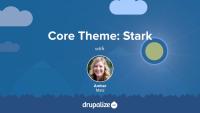Breakpoint API in Drupal
CourseIt's time to create the bare-bones structure for a new theme on your site. You should try to complete this exercise based what you've learned from the tutorial prerequisites listed below. The video at the end of this tutorial will walk you through the implementation of this exercise if you need some help. In this exercise, we'll:
- Create an info file that describes a custom theme to Drupal with the regions listed below (we're going to name ours "reboot").
- Enable, and view, a bare-bones custom theme.
By the end of this exercise, you should feel comfortable starting a theme using several methods.
Broken Feeds and Spaces in Your Code
Blog postIf you receive our newsletter, you may have noticed that you recently got a HUGE list of posts we've written recently. Well, except that they weren't all really that recent — some of those we two months old, and every week in between. Our regular newsletter is sent out automatically based on our RSS feed, and it turns out that our RSS feed was broken. Once we tracked it all down and got it fixed, all of the posts that had never gotten queued up for the newsletter shot out in one big go. Sorry about that. Aside from the crazy long newsletter though, I thought I'd share how I got this sorted out, because this is the kind of problem that can happen to anyone, and it is really annoying to track down.
Core Themes: Stark
FreeStark is one of the themes bundled with Drupal. It is intentionally bare bones and its purpose is to help Drupal theme and module developers get to the heart of Drupal's system templates. In this tutorial, we'll explore Stark and its primary features and discuss the various reasons for utilizing the Stark theme.
Themes provide the HTML, CSS, JavaScript, and other assets that are responsible for the look and feel of your site.
Our Favorite HTML and CSS Resources
Blog postYou want to learn HTML and CSS, or maybe you just need a refresher on the current state of web technology—where should you start? This is a question we get asked a lot at Drupalize.Me. Our theming and module development videos often assume that you're familiar with basic HTML and CSS, so here is a list of our favorite resources.
One of the features of any content management system's architecture is the separation of presentation and data. In Drupal, modules are responsible for figuring out what should be on the page, and themes are responsible for the final look and feel of anything shown in the browser. It's vital for a module to return themeable output, so that the active theme can determine how it's presented.
In this tutorial, we'll:
- Define themeable output.
- Show how modules can avoid embedding presentation data in their output.
- Explain why Drupal favors structured arrays over HTML strings for data presentation.
By the end of this tutorial, you will be able to articulate the role modules play in enabling themes to customize a Drupal site's appearance.
Themes define the regions that are available for site administrators to place blocks in, creating a layout framework within which the components that compose a page can be placed. As a theme developer you'll need to determine what regions are necessary to accommodate your design's layout, while also ensuring it'll work with the way Drupal uses blocks to place content onto the page. Deciding what regions to create requires knowledge of how Drupal works and a clear vision of the design you're trying to achieve.
In this tutorial we'll:
- Explain what regions are and how they relate to themes
- Describe how regions are handled internally within Drupal
- Demonstrate things to keep in mind when planning the regions for your custom theme
By the end of this tutorial you should be able to describe what a region is, explain how Drupal themes use regions to place content, and get started dissecting your own designs into regions.
Setting up Your Developer Environment
Blog postIn my new position at Drupalize.Me I have the luxury of helping a lot of projects in little ways. Being able to context switch quickly helps a lot. This means I've put a lot of time into how my workstation is setup so that I can easily move from one project to another. With the new job I also decided to add OSX to the mix of computers that I use on a daily basis.
Dive in to DrupalCon
Blog postJoe's list: 2019 DrupalCon events and classes for those new to Drupal
If you’re anything like me, you’ve been meaning to get involved with Drupal 8 for quite some time now. But where to start? What’s left to be done? How do I find tasks that match my skills? Enter Core contribution mentoring.
As we learned in the What Is a Breakpoints YAML file? tutorial, modules and themes can expose their site's CSS breakpoints and media queries to other Drupal modules and themes by implementing a breakpoints YAML file. In that tutorial, you also learned about the structure of a breakpoints configuration file and why you'd want to create one. In this tutorial, we’ll walk through the process of creating an example breakpoints file step-by-step.
By the end of this lesson, you should be able to create a working breakpoints YAML file in a theme or module. We'll test it out by enabling Drupal's Responsive Image module, where we'll be able to see it listed in the configuration form for creating a new responsive image style.
One of the best parts of doing an upgrade on an existing site is that it gives you the opportunity to fix things that need fixing. Of course, we’re very focused on our users as our first priority when it comes to working on the site, but we, as the site administrators, need some usability love too.
Clear Drupal's Cache
FreeKnowing how to clear Drupal's cache is an important skill for any developer. You'll likely find yourself doing it frequently in order to get Drupal to register the changes you make to your code, or other updates you make via the UI. It is also a good first step to trouble shooting problems with your Drupal site: Clear the cache before you do any other debugging to ensure it's not just a bad cache entry.
Drupal comes with all of its caching features enabled by default. This improves response time, but can be frustrating for themers as it makes it harder to preview the changes you make to template files.
In this tutorial we'll look at:
- Why these features are enabled by default
- How the theme layer leverages Drupal's caches
- Why you should learn to disable them when doing development
This tutorial demonstrates how to locate the template file that is currently being used to render an element and override it in your own theme. This is an important skill for anyone who wants to make changes to Drupal's default HTML markup.
In this tutorial we'll:
- Override the node.html.twig template in our theme
- Make changes to the markup
- Create a content-type-specific template override like node--CONTENT_TYPE.html.twig
By the end of this tutorial you should be able to modify the HTML markup used to display a node, or any other element of the page generated using a template file.
To add CSS or JavaScript files or libraries to your site, you can attach them as asset libraries in your theme. In this exercise, you'll create 2 asset libraries and attach them globally via your theme's info file. In this tutorial, we'll pull in the CSS and JavaScript from the popular Bootstrap framework so that we can make use of its layout utility classes later on. We'll also add a custom CSS file that contains global styles for our site, like setting the page background color.
If you want to try and complete this on your own first you'll need to:
- Add the Bootstrap CSS and JavaScript files to your theme.
- Define an asset library using a THEMENAME.libraries.yml file in your theme.
- Tell Drupal to attach your asset library so that the CSS and JavaScript files it represents are included in the page.
Once that's done your site won't look all that different. But if you view the page source, or look closely, you should see that the Bootstrap files are included along with any CSS rules you placed into your custom style sheet.
Note: Since this course is focused on teaching the Drupal aspects of theme development, and not on writing CSS, we're using the Bootstrap CSS. Feel free to use the framework or library of your choice if you don't want to use Bootstrap.
You should try to complete the exercise steps on your own and use the video to help guide you if you get stuck.
At the end of this exercise, you'll find a video walk-through of the solution.
In order to change Drupal's default markup you need to override template files. The page template controls the overall layout of your theme, including the placement of regions. You should practice the exercise following the written instructions below. Use the video walk-through to help if you get stuck.
In this exercise, we'll:
- Override the currently used page.html.twig template file.
- Modify the content of the file to include the regions defined in the theme's .info.yml file.
- Wrap the regions in the page template file with HTML markup using CSS classes from Bootstrap to achieve the example layout.
By the end of this tutorial, you'll gain practice creating a custom layout in a page template file.
Concept: Render API
FreeDrupal's Render API plays a crucial role in how content is presented on a site. The Render API manages how content is rendered through render arrays and render elements.
In this tutorial, we'll:
- Define render arrays, highlighting properties and elements.
- Explain how render elements are used as shorthand for complex structures.
- Describe the primary types of data we can use in a render array.
- Touch on the role of renderers and special methods for rendering entities.
By the end of this tutorial, you'll better understand how Drupal constructs a page's output through render arrays and streamlines rendering with render elements.




